#project management visual board
Explore tagged Tumblr posts
Text
How To Become A Brand New Person ✨✨
Self Reflect:
Journal daily.
Think about past decisions and how they impacted your life.
Meditate regularly.
Create a vision board to visualize your goals.
Review your strengths and weaknesses.
Identify your core values and beliefs.
Figure out your passions and interests.
Think about your childhood dreams and aspirations.
Evaluate your current state of happiness and fulfillment.
Set Clear Goals:
Define specific career goals, like "Get promoted within two years."
Set health goals, like "Lose 20 pounds in six months."
Create financial goals such as "Save $10,000 for a vacation."
Establish personal development goals, like "Read 24 books in a year."
Set relationship goals, such as "Improve communication with my partner."
Define education goals, like "Complete a master's degree in three years."
Set travel goals, like "Visit five new countries in the next two years."
Create hobbies and interests goals, such as "Learn to play a musical instrument."
Set community or volunteer goals, like "Volunteer 100 hours this year."
Establish mindfulness or self-care goals, such as "Practice meditation daily."
Self Care:
Exercise for at least 30 minutes a day.
Follow a balanced diet with plenty of fruits and vegetables.
Prioritize getting 7-9 hours of quality sleep each night.
Practice in relaxation techniques like deep breathing or yoga.
Take regular breaks at work to avoid burnout.
Schedule "me time" for activities you enjoy.
Limit exposure to stressors and toxic people.
Practice regular skincare and grooming routines.
Seek regular medical check-ups and screenings.
Stay hydrated by drinking enough water daily.
Personal Development:
Read a book every month from various genres.
Attend workshops or seminars on topics of interest.
Learn a new language or musical instrument.
Take online courses to acquire new skills.
Set aside time for daily reflection and self improvement.
Seek a mentor in your field for guidance.
Attend conferences and networking events.
Start a side project or hobby to expand your abilities.
Practice public speaking or communication skills.
Do creative activities like painting, writing, or photography.
Create a Support System:
Build a close knit group of friends who uplift and inspire you.
Join clubs or organizations aligned with your interests.
Connect with a mentor or life coach.
Attend family gatherings to maintain bonds.
Be open and honest in your communication with loved ones.
Seek advice from trusted colleagues or supervisors.
Attend support groups for specific challenges (e.g., addiction recovery).
Cultivate online connections through social media.
Find a therapist or counselor for emotional support.
Participate in community or volunteer activities to meet like minded people.
Change Habits:
Cut back on sugary or processed foods.
Reduce screen time and increase physical activity.
Practice gratitude by keeping a daily journal.
Manage stress through mindfulness meditation.
Limit procrastination by setting specific deadlines.
Reduce negative self-talk by practicing self-compassion.
Establish a regular exercise routine.
Create a budget and stick to it.
Develop a morning and evening routine for consistency.
Overcome Fear and Self Doubt:
Face a specific fear head-on (example: public speaking).
Challenge your negative thoughts with positive affirmations.
Seek therapy to address underlying fears or traumas.
Take small, calculated risks to build confidence.
Visualize success in challenging situations.
Surround yourself with supportive and encouraging people.
Journal about your fears and doubts to gain clarity.
Celebrate your accomplishments, no matter how small.
Focus on your strengths and accomplishments.
Embrace failure as a valuable learning experience.
Embrace Change:
Relocate to a new city or country.
Switch careers or industries to pursue your passion.
Take on leadership roles in your workplace.
Volunteer for projects outside your comfort zone.
Embrace new technologies and digital tools.
Travel to unfamiliar destinations.
Start a new hobby or creative endeavor.
Change your daily routine to add variety.
Adjust your mindset to see change as an opportunity.
Seek out diverse perspectives and viewpoints.
Practice Gratitude:
Write down three things you're grateful for each day.
Express gratitude to loved ones regularly.
Create a gratitude jar and add notes of appreciation.
Reflect on the positive aspects of challenging situations.
Show gratitude by volunteering or helping others in need.
Send thank-you notes or messages to people who've helped you.
Keep a gratitude journal and review it regularly.
Share your gratitude openly during family meals or gatherings.
Focus on the present moment and appreciate the little things.
Practice gratitude even in times of adversity.
Be Patient:
Set realistic expectations for your progress.
Accept that personal growth takes time.
Focus on the journey rather than the destination.
Learn from setbacks and view them as opportunities to improve.
Celebrate small milestones along the way.
Practice self-compassion during challenging times.
Stay committed to your goals, even when progress is slow.
Keep a journal to track your personal growth.
Recognize that patience is a valuable skill in personal transformation.
Celebrate Small Wins:
Treat yourself to your favorite meal or dessert.
Reward yourself with a spa day or self-care activity.
Share your achievements with friends and loved ones.
Create a vision board to visualize your successes.
Acknowledge and congratulate yourself in a journal.
Give yourself permission to take a break and relax.
Display reminders of your accomplishments in your workspace.
Take a day off to celebrate a major milestone.
Host a small gathering to mark your achievements.
Set aside time to reflect on how far you've come.
Maintain Balance:
Set clear boundaries in your personal and work life.
Prioritize self care activities in your daily routine.
Schedule regular breaks and downtime.
Learn to say "no" when necessary to avoid overcommitment.
Evaluate your work life balance regularly.
Seek support from friends and family to avoid burnout.
Be kind to yourself and accept imperfections.
Practice mindfulness to stay present and grounded.
Revisit your priorities and adjust them as needed.
Embrace self love and self acceptance as part of your daily life.
#personal improvement#personal development#personal growth#self help#self awareness#self reflection#self improvement#level up journey#self love journey#dream girl guide#dream girl journey#dream girl tips#becoming that girl#that girl#it girl#glow up tips#glow up#clean girl#pink pilates girl#divine feminine#femininity#femme fatale#feminine journey
7K notes
·
View notes
Text
Random QL Superlatives: 2024 Edition
My friends! It is time once again to reflect back on the year and give out some random ass awards to the things that gave me joy in the many QLs I watched.
In no particular order, this year’s winners:
Best Long Term Glow Up: Off Jumpol as Jane in The Trainee

I've been simping for Jumpol since the Puppy Honey days, because I know potential when I see it! This year the rest of y'all finally caught up with me and realized this man is aging like a fine wine. We all won!
Most Valuable Prop: Aoyanagi Hajime Standee, I Became the Main Role of a BL Drama

Will anything ever make me laugh as hard as Akafuji opening the door to Aoyanagi Hajime while holding an Aoyanagi Hajime standee and then running for his life, standee tucked under his arm, to escape the mortification? If so, it's def another joke from this show.
Best Heart Destroying Angst: Every Moment of Let Free the Curse of Taekwondo

Sometimes you just want a show to break your heart into a million tiny pieces and then stitch it back together, and there is no better version of that experience this year than this beautiful show.
Wackiest Premise That Somehow Works: Caged Again

Whomst could have predicted that a BL about a penguin who turns into a human, goes to high school, and falls in love with a panther would be one of the sweetest, most compelling stories of the year.
Most Precious Bean: Taishin, Takara's Treasure

Just look at his cute little face!! My son has never done anything wrong in his life. He's adorable and I won't hear a word against him.
Drama Child of the Year: Young San, Century of Love

My soul fully tried to leave my body every time this child appeared on screen. I must congratulate this child actor--his name is Chayanan Akkharadumrongdet--on perfectly embodying the spirit of an old man trapped in a tiny body. Give this boy an award!
Best Love Theme: Di Inakala by Paul Pablo, Marahuyo Project
youtube
Such a gorgeous song, first used while King reads Ino's letter and realizes Ino has feelings for him. Hits me right in the chest every time I hear it.
Best Sex Scene - Almond and Latte's first time, Knock Knock Boys

Everyone else can throw in the towel, this is the best depiction of a loving but awkward first time that will ever be committed to film.
Star of My Vision Board: Yako, She Loves to Cook and She Loves to Eat

Oprah said it best: “She is the mother I never had, she is the sister everybody would want. She is the friend that everybody deserves. I don't know a better person.”
Outstanding Achievement in Old Man Yaoi: Mr. Mitsuya's Planned Feeding

It's not every day that a show manages to sell you on a 20+ year age gap, but this one did it without breaking a sweat and had us all rooting for Ishida to eat that old man up with a spoon.
Best Sight Gag: Rock Lifting Karan Over His Shoulder, Cherry Magic Thailand


Is it the way Rock bends down and grabs him with no warning? The way Karan still does a polite wai over his shoulder? The way Dujdao scurries after them? Idk but it's been 10 months and I am still laughing.
Best Absolute Mindfuck: Love for Love's Sake

Sometimes a scene from this drama will flash through my mind and I'll have to spend a few minutes just staring at the wall, and that's how you know it was damn good.
Most Brainrot Inducing: Unknown

The way this story had a chokehold on my brain for three entire months was no joke.
Swooniest Love Interest: Mahasamut, Love Sea

Just look at this glorious man! And on top of all that visual splendor, he's kind and generous and brave and smart and competent and high key a smart ass. In this house we love Mahasamut!
Best Classic Watch: The Miracle of Teddy Bear

The most delightfully surprising watch of the year for me, and a great reminder to never, ever trust anything MDL commenters say about a show.
Y'all know the drill: feel free to join in and post your own superlatives, and please tag me if you do!
#bl superlatives 2024#the trainee#i became the main role of a bl drama#let free the curse of taekwondo#caged again the series#century of love#knock knock boys#cherry magic th#love for love's sake#she loves to cook and she loves to eat#love sea the series#unknown the series#mr mitsuyas planned feeding#the miracle of teddy bear#takara no vidro#marahuyo project#shan shouts into the void
204 notes
·
View notes
Text
December lock in to do list : the last fresh month ⑅𑂳⠀ 🎟️⠀ᜓ⠀⠀ᰔᩚ ᮫
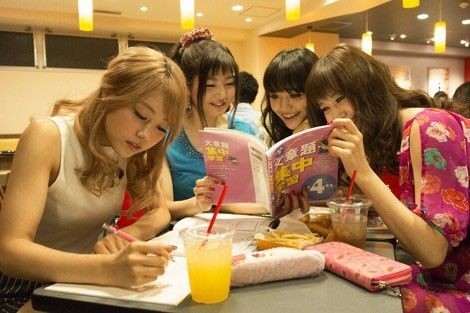
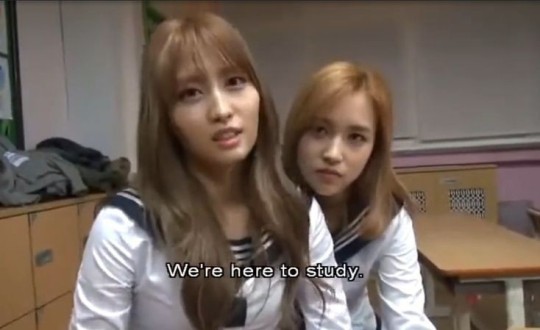
As the final month of the year rolls in, it’s the perfect time to reflect, reset, and make the most out of these last few weeks. Here's your ultimate December Lock-In To-Do List to end the year on a fresh note and prepare for the year ahead!
1. Reflect & Recharge:
Take time to reflect on your year so far—celebrate your wins and learn from the challenges.
Allow yourself to rest and recharge before diving into the new year.
Journal about your experiences and things you’ve learned.
2. Set Intentions for the New Year:
Get clear on what you want to accomplish in 2025—write down your goals and dreams.
Create a vision board or a digital mood board for inspiration.
Set small, achievable steps towards these big goals.
3. Organize & Declutter:
Tidy up your space—whether it’s your room, your study area, or your digital life.
Declutter your belongings, get rid of anything that no longer serves you.
Organize your files, notebooks, and study materials for the new year.
4. Master Time Management:
Set up a daily or weekly planner to help stay on track with your study and personal goals.
Break your tasks into smaller, manageable chunks, and stay consistent.
Use the Pomodoro technique for focus (it's my fav technique ): 25 minutes of studying, followed by a 5-minute break.
5. Focus on Self-Care:
Stick to a skincare routine to keep your skin fresh and healthy.
Get at least 6 to 7 or 8 hours of sleep each night and practice relaxation techniques like meditation . (My timetable don't allow me to sleep 8h 🥹 )
Nourish your body with balanced meals, hydration, and gentle exercise.
6. Prepare for Finals & Tests:
Review your notes and start preparing early for any upcoming exams or projects.
Set study goals each day—focus on one subject at a time to avoid burnout.
Use active learning methods: rewrite notes ,practice with mock tests, flashcards, and past papers.
7. Learn Something New (Mandarin):
Make a goal to learn something new this month—(for me it's Mandarin) for example new language or sports.. skill you’ve been curious about.
Dedicate 15-30 minutes a day to practice through apps or free website classes .
Keep your learning fun and engaging by practicing speaking, listening, and writing.
8. Boost Focus & Motivation:
Visualize your success and stay motivated throughout December by setting daily goals.
Reward yourself after completing tasks—small celebrations can keep you motivated.
Create a playlist that energizes you while studying or working. (Click to listen to my Spotify playlists !)
9. Stay Positive & Stay Grateful:
Make gratitude a habit by writing down 3 things you’re grateful for every day.
Reflect on the positive things in your life and keep a positive mindset, especially when things get tough.
- ! Remember, this is a fresh month—anything is possible!
📋- @bloomzone
#bloomivation#bloomdiary#girl blogger#girl blogging#girblogger#dream girl journey#dream life#divine feminine#creator of my reality#becoming that girl#glow up#wonyoungism#wonyoung#it girl#it girl affirmations#soft pink#clean girl#gyaru#get motivated#lock in#pink blog#study blog
308 notes
·
View notes
Text
*screaming*
*continued screaming*
Okay. So. My introductory Visual C# class.
The professor for that class was Alice. Alice was the person who spoke in the introductory video and the person who we were supposed to email if we had any issues.
But all of the assignments, lectures, and quizzes were written and delivered by Bob. On the youtube channel "Bob's programming academy." The quizzes included Bob's name, like "if you do X will it return the string ProfessorBob, Professor, Bob, or Professor.Bob?"
This class was really frustrating for me because it was structured in such a way that you could easily pass the class with zero knowledge of the subject - it was totally based on quizzes that you could take an unlimited number of times and we *had* weekly programming assignments but they weren't graded so there was no incentive to do them (and look, if I wanted to teach myself programming with no incentives I could fail for several years to do that on my own, I don't need to pay fifty bucks a unit for that; the reason I am in a *class* and am not self-taught is because I need external motivation. That's why I sought out a class).
Also when there *was* a problem with an instruction that was unclear in one of the videos for the assignments, or if I thought I'd done something correctly that was very much incorrect, it wasn't Alice who had created the instructions, it was Bob - in 2017 no less - and I didn't really feel like I could ask Alice for help with an ungraded assignment that she hadn't written.
So. Now. My Python class.
Today is the first day of class. Professor is Charles.
I go to the mandatory attendance quiz and it is word-for-word the same mandatory attendance quiz as the C# class, down to the final question "what is your personal email address so I can keep in contact with you after the semester?"
I look at the syllabus.
Class grade is based on quizzes. We have assignments but none of them are graded. There's no textbook, just a series of videos from Professor Bob's Programming Academy.
So I'd been toying with staying at this school and trying to take more CS classes instead of going to another school, just to try to keep my records easier to manage, but since it seems like that *ENTIRE DEPARTMENT* is five Professor Bobs in a trenchcoat, I will probably be going somewhere else (and once again trying to force myself to do projects that I already know are *good for me to do* but *useless for the class and a massive time suck*)
I should drop this class. I should drop this class and apply for the other school so that I can start taking classes there in the spring because if I take this class and then go into the object oriented programming class in the spring and it's another professor bob sock puppet and I end up taking twelve units of programming classes where all I learn is how to google answers in a short time frame (something I already know how to do thanks) I am going to fucking lose it.
Also, again: I have a Bachelor's Degree. I spent five years at a community college when I was getting that degree. I took probably a dozen online classes starting in 2005 and going until 2011 in the process of getting that degree.
THIS bullshit, this "I'm your professor but actually I'm not and all the materials were created by someone else in the department or came directly from the textbook publisher and there is no writing and there are no assignments everything is multiple choice quizzes that are automatically graded" is *dogshit.*
This is NOT how online classes worked back in my day, not even online math classes, and as much as I know adjuncts are getting fucked over by academia in general, this isn't something that these professors should be getting paid as much as they are to do. Alice checked whether or not students turned in a hello world assignment and gave a pass/fail grades for three discussion boards that were responses to youtube videos. Nothing else in the class required her input. If this is the level of instruction that students are getting then the class is already automated and the students shouldn't have to pay for it.
This is crap. This is an incredible level of crap.
908 notes
·
View notes
Text
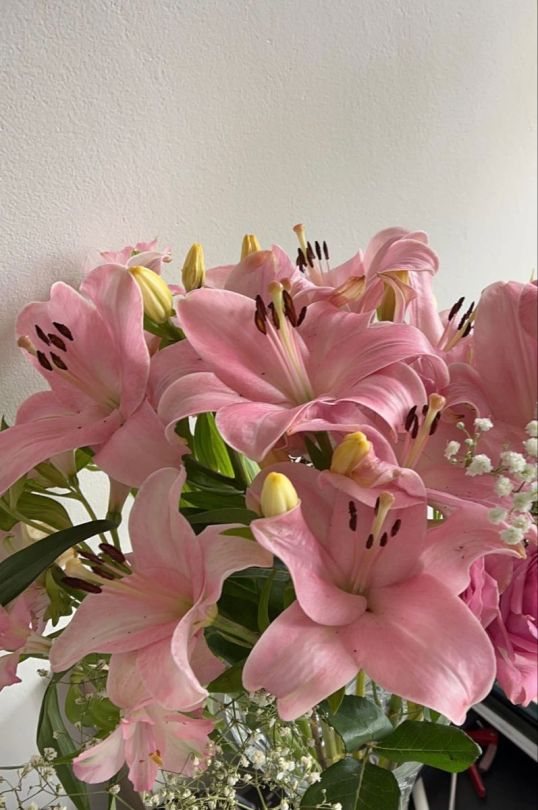


time management
time management is all about planning and controlling how you spend your time to be more efficient and productive. some key strategies to help you manage your time better include:
・prioritize tasks: identify what's most important and tackle those tasks first. you can use methods like the eisenhower matrix to categorize tasks by urgency and importance.
・set goals: having clear, achievable goals can help you stay focused and motivated. break down larger goals into smaller, manageable tasks.
・create a schedule: plan your day or week in advance. allocate specific time blocks for different activities and stick to your schedule as much as possible.
・avoid multitasking: focus on one task at a time. multitasking can reduce your efficiency and increase the chances of making mistakes.
・take breaks: regular breaks can help you stay fresh and maintain high levels of productivity. techniques like the pomodoro technique, which involves working for 25 minutes and then taking a 5-minute break, can be very effective.
・eliminate distractions: identify what distracts you and find ways to minimize these interruptions. this could mean turning off notifications, setting boundaries with others, or creating a dedicated workspace
for example, sometimes i get so caught up with talking to my friends online that i forget to start my homework when i get home. an easy solution is to simply move my phone out of the room.
・review and adjust: regularly review your progress and adjust your plans as needed. this helps you stay on track and make improvements over time.
do you have any specific areas where you struggle with time management?
there are several great time management apps that can help you stay organized and productive. here are a few popular ones:
todoist: a comprehensive app for managing tasks and projects. it’s available on multiple platforms and integrates well with other tools like gmail and slack.
toggl track: ideal for tracking work hours and managing schedules. it’s great for freelancers and small businesses.
forest: a unique app that uses a gamified approach to help you stay focused. you grow a virtual tree by staying on task, and if you get distracted, the tree dies.
notion: an all-in-one workspace that combines notes, tasks, and project management. it’s highly customizable and great for both personal and team use.
clockify: a free time tracking app that helps you track work hours across projects. it's useful for individuals and groups.
trello: a visual tool for organising tasks and projects using boards, lists, and cards. it’s great for collaboration and keeping track of multiple projects.
thanks for reading! remember, mastering time management is a journey, not a destination. stay focused, stay organized, and make every moment count.
feel free to reach out if you have any questions or need more tips!
❤️ nene
#that girl#becoming that girl#student#productivity#study blog#student life#chaotic academia#academia#nenelonomh#study#ibdp#ibdp student#study motivation#studyblr community#study notes#study with me#international baccalaureate#diploma#ib diploma#studyblr#studying#100 days of studying#study inspiration#study inspo#study community#study space#time management#self improvement#self love#self care
285 notes
·
View notes
Text
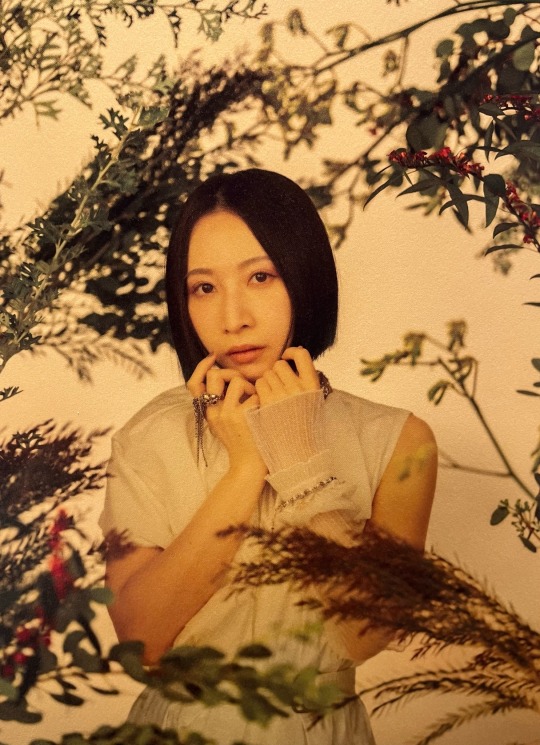
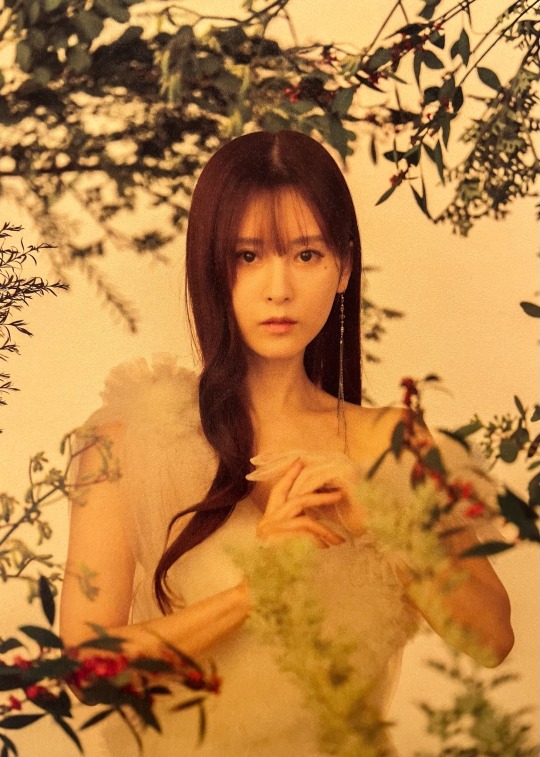
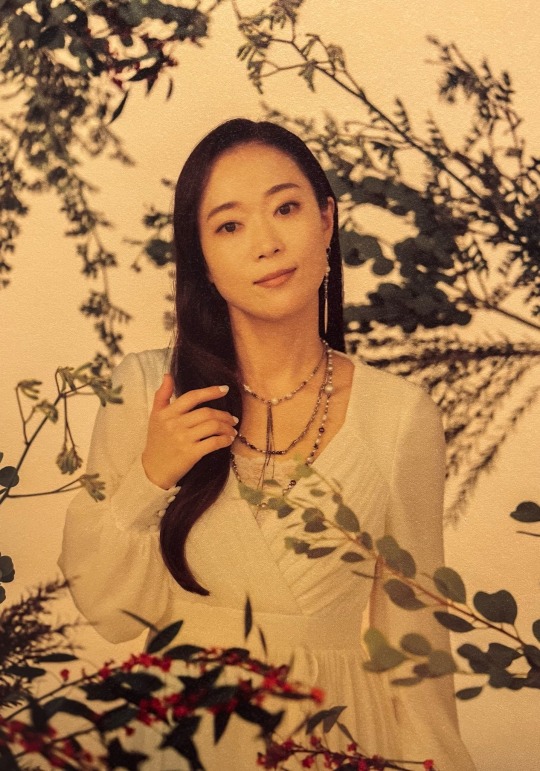
Kalafina Anniversary Live 2025 Report
It's finally here, sorry for the long wait!! Let me share some overall thoughts first( ^_^)/~~~
Venue: Probably the newest and fanciest venue I‘ve ever been to. Loved all the screens with Kalafina visuals. They had them across the entire area, some bigger, some smaller and a really big one in front of the venue itself. The theater appeared to be a bit intimidating at first glance but I actually appreciated the layout, I feel like you got to have a pretty decent view from most places, even in the upper balconies.
Collaboration events: This one was somewhat of a fail for me. Originally, I wasn’t too impressed with most of the collaboration food but I was still eager to get it, especially the stuff that was wrapped nicely. The chocolates looked lovely but they were already sold out when I arrived at 11:00 on the 15th.🥲Was also planning to get the katsu sandwich in the Kalafina packaging but that was sold out as well. Not afraid to admit that I cried a little when I realised I woudn't be able to get them...I did get one of those gorgeous tray sheets at Taco Bell at least🙌 Managed to secure one of those tiny photo cards too but meh, honestly nothing to write home about. Gave me the opportunity to write something on the message board though so that’s a good thing 👍 The whole gacha situation was a challenge to say the least. So exhausting! I got a numbered ticket (#127) for the queue so I could start lining up at 13:30 (was actually one of the first people to enter). This worked out pretty smoothly and everyone was able to enter earlier than expected. At first I was lining up in the wrong queue because they were telling people they had to go through the on-site merch sale area first. Thankfully, a staff member came over and guided me and some others to the direct queue (after all, I wasn’t planning to buy any merch since I had already made my reservation). My first gacha round didn’t take too long since most people were still busy buying merch and there were a total of ten machines (also had prepared my 500 yen coins the day before so I didn't have to line up to change my money). I was moderately lucky but didn’t get some of the items I wanted🙃 So after I picked up my live goods during my assigned time slot, I got back in the queue to do a second gacha round😅. This time the wait was long, probably an hour or so. Also, 10,000 yen just gone☠️Thanks to @concretebadger and my super kind friend, I managed to get the complete set! BANZAI🤗 I also got two lovely tokutens for participating in the big flower stand project (a postcard and badge of the drawing). Almost didn't get to meet up with the organisers of the project but thankfully I ran into them right before the start of the show (generally, I find it fascinating how many people I managed to run into despite the sheer amount of people at the venue - thanks to everyone who said 'hi').
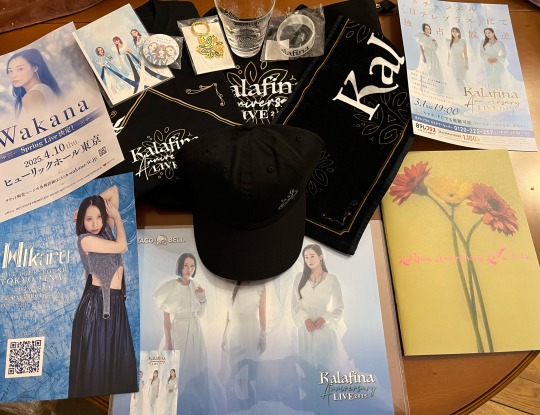
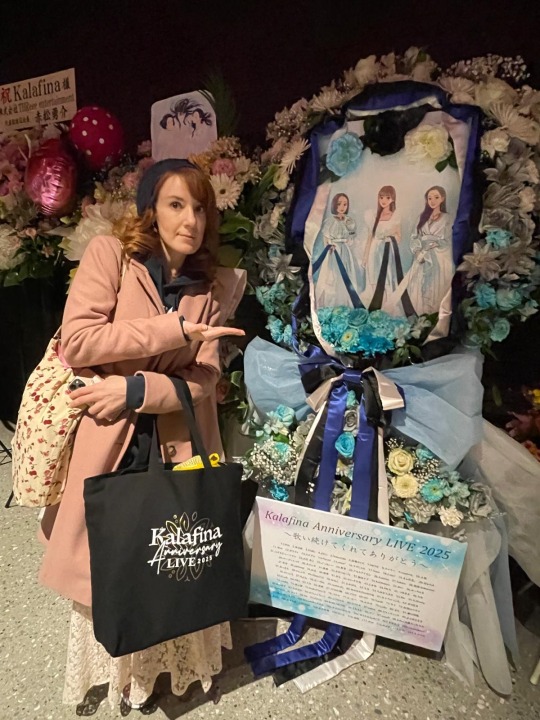
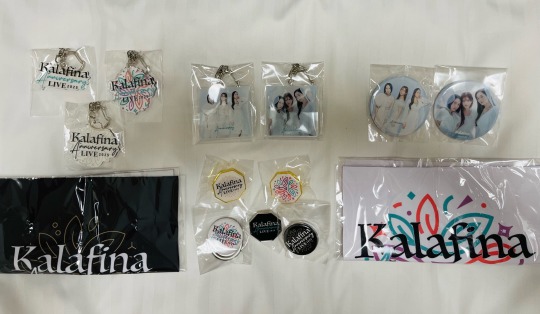
Seat: I really liked my seat and am glad I went for the balcony area. Had a completely unobstructed view of the stage🥰It was a little further away of course but I did bring my binoculars so it was fine.👍 In my vicinity people were thankfully not very keen to stand up all the time so I had one less thing to worry about. The screens on the side were also a perfect size to see their facial expressions. The people in charge of the projections made sure to include a lot of close-ups 😍 Bless them!
Sound: Maybe it was just my specific location towards the left side on the balcony but the sound system was a bit off I think, or possibly the manipulator did a horrible job with the mixing? How did everyone else feel about this? The background music was often overly loud (if not to say obnoxiously noisy) and drowned out the vocals. During some parts, it was honestly hard to hear the girls among all the other noises. It was much better during songs that had a more simple or acoustic arrangement. The microphones seemed to have some issues too at times because there were a few distortions (?) which made their voices sound different (?) and occasionally, you just couldn’t hear them singing the beginning of certain lines - this could theoretically be chalked up to them being hesitant and starting too quiet (Wakana does that at times) but it happened a little too often to all three of them which is why I‘m assuming there might have been some technical issues.
Vocals: What are seven years? Nothing! It was like no time had passed at all! Some people may disagree but for the most part, the girls sounded amazing to me! I thoroughly enjoyed myself and very rarely heard notes that made me cringe. I was amazed how they managed to just pick up where they left off. Of course there were parts that were less flattering and they had some of their usual hiccups but I feel like they handled everything pretty well. Have they done better and more polished live renditions of some of these songs in the past? Probably (tho there were some stand-out performances that impressed me more than their old versions). Overall, there was clearly a lot of effort and love put into each and every performance and at the end of the day, that's all that counts for me. They didn’t “phone-in” their singing, they put all their heart into it and you could tell. I even liked songs that I am usually not such a huge fan of (e.g. “ring your bell” and “ Alleluia”). Also, say what you will but there’s a huge contrast between the YKL Kalafina covers and the real thing, it’s almost jarring how different they sound so I particularly appreciated performances of the songs that had previously been covered at YKL. Needless to say, I much prefer the real thing! It's just not the same without Wakana and I must say, Wakana delivered solid vocals during most songs that required those super high and long notes. Hikaru also did a great job and sounded powerful throughout most of the setlist. She was getting visibly tired though towards the end of the up-beat section (Wakana on the other hand surprised me with her stamina). As for Keiko, do I even have to say it? She delivered a fabulous performance as one would expect from her. She nailed all her epic long notes (e.g. “Hyakka Ryouran”, “Kyrie”, “Hikaru Furu” - she sounded better than she did during the 10th Anniversary Live if you ask me)
Production & arrangement: Honestly nothing special or outstanding. They kept it simple and remained faithful to Kalafina’s usual M.O. The focus was on their voices and there wasn’t anything extravagant to distract from that. On the contrary, I feel like there was a conscious effort being made to include more acappella parts to highlight their harmony. With the exception of a few instrumentals and solos, I don’t think Satoshi Takebe added a lot of creative twists to change the original sound. He even mentioned in a tweet that he wanted to pay tribute to Yuki Kajiura’s work, stay true to her music/style and not make it his own or anything. On this note, I would like to add that YK's absence was not really an issue. As I have mentioned a few times already, YK has rarely been an integral part of their live productions so her not being in charge of this concert, has done nothing to affect its quality.
Atmosphere: 1000/10. The girls were in such a good mood and determined to make this concert the best experience ever. It really felt like they had never been apart. Their interactions with each other were heart-felt and didn’t come across as staged or forced. You could tell how much they missed performing together. The audience was also super responsive and everyone seemed to have the time of their lives (myself included of course).
Setlist: Admittedly, it wasn’t what I had hoped for but it was pretty much what I had expected from this sort of live so I can’t be mad. And there were a few really pleasant surprises that I didn’t think they would include (“Hanataba”, “Lacrimosa”, “Kyrie” and “Hyakka Ryouran”) so YAY for that. Also beyond happy that they did an acoustic version of “sprinter” because that’s so much better than the studio version (which I typically don’t like). Same goes for "KnGnN". Check out a detailed report below the cut 〈(•ˇ‿ˇ•)-→
1 oblivious: I knew it was coming and it’s usually not a song I’m particularly fond of but this performance may have been the best one I’ve ever heard (biased opinion but hey, you can’t blame me for that😅). The song kicked me right in the feels! Or maybe it was just like a dream come true to hear/see them together again! When they appeared on stage, they looked like angels. What a revelation to see them in all their glory once the sheer curtain was dropped. They sounded amazing, absolutely breathtaking! Was impressed by everyone’s vocals. Shout-out to Hikaru for her high notes! For a few lines in the beginning, Wakana didn’t quite sound like herself (the distortion I was talking about earlier?) but I am not sure if it was a lowered pitch or something the manipulator did on purpose to smooth out her voice. It sounded okay and wasn’t too distracting so I didn’t mind it. Later on, her voice sounded like it usually did during “oblivious” so maybe it was just a glitch or whatever. When Wakana and Keiko did their little back-and-forth duet thingy, I almost started crying because I had missed them so much. WaKei FOREVER 🤗
2 Kizuato: A bit bummed that they didn’t perform “Kimi ga Hikari ni Kaete Iku” (then again, I might have died instantly so it was probably a good thing) but this was a beautiful performance so I can’t complain. The three of them once again sounded amazing and their harmonies were to die for.
3 Mirai: Typically one of their weaker live performances and this was no exception. But really, it’s about getting that connection with the audience, running around on stage, greeting the audience and having fun. I don’t mind if it’s not polished and I usually don’t even pay attention to that during this song.
4 Hikari no Senritsu: Felt a bit all over the place so I wasn’t quite able to get into it. The music was overbearing at times and it took away from the charm of a few individual lines. I expected to be touched by the performance since Keiko had been going on and on about how this was her favourite song to sing together but I didn’t have a particularly strong reaction to it. To be fair though, it has never been one of my favourite songs so that might have been the reason for my rather lukewarm reaction. An interesting cello solo from Masateru spiced things up a little but otherwise, there weren’t any significant changes.
5 storia: For this one, I always keep my expectations low regarding vocals because I know it’s a hit and miss when it comes to Wakana and Hikaru. It’s been like this forever so I’m not surprised to hear them struggling at times. Nevertheless, this is a song I have always enjoyed so I can easily look past minor issues. As expected, the girls did struggle a bit (Hikaru in particular didn't deliver the most flattering performance) but it was totally fine. That final chorus once again caught me right in the feels, especially the WaKei part🥹Both the YKL cover and Wakana's solo cover are still fresh in my mind so to finally hear the song as it is meant to be, feels like such a blessing.
6 ring your bell: The piano intro was a bit misleading and for a couple seconds there, I seriously thought they would be introducing a brand new song 😅 It was a nice touch though, I do enjoy intros like that (probably Takebe's idea). Surprisingly, I liked this performance more than I thought I would. I usually give this one a pass because I don't care for the unflattering vocals. I've never understood why it keeps getting performed when it is such a challenging song. But this time, I honestly enjoyed almost all of it (especially Wakana's parts at the end- she did a great job here). Those YK cover versions pale in comparison if you ask me.
7 Hanataba: What a surprise! 😮 Possibly one of their best (if not the best) performances of the night. Usually not a fan of the accordion but here I didn’t mind it. They made some minor changes to the arrangement to highlight the accordion and the vocals. The girls were on fire, especially Hikaru. You could tell she was happy that her chosen song made it onto the setlist.
8 Lacrimosa: From one surprise to another. I was actually expecting them to sing “Consolation” at this point because according to the previous MC, this was meant to be their “Consolation” album block. Would have been happier with “Consolation” to be honest but “Lacrimosa” was a nice treat too. The background music was quite loud again so some vocal parts weren’t discernible or got overshadowed by other stuff.
9 Manten: I don't remember much from it so it must not have stood out to me.
10 to the beginning: Never liked it but this time, I had a blast. A fantastic performance with so much energy and love put into it. The audience went crazy of course so that was also fun to watch. While I personally do not stand up for songs and categorically refuse to partake in any weird arm movements (clapping is the most I will do), I still think it's nice to see everyone so invested.
11 Kimi no Gin no Niwa with strings: This was beautiful. Just strings and piano, might have been my favourite rendition of all time (and I am usually not even such a huge fan of the song). Quite a few more acappella lines than usual I think. Gorgeous arrangement.
12 sprinter with strings: What can I say? Perfect. No notes. Tears everywhere. So glad they decided to go for an acoustic version (by now we all know how much I dislike the studio version). It wasn't as emotional as that Arena Live encore performance but for me, it came pretty close.
13 Hyakka Ryouran: Became a big fan after the 10th Anniversary performance. Didn't expect them to include it once again in the setlist but I certainly didn't mind. This one was just as solid I would say although I feel like Keiko was actually a bit stronger here than she was back then, especially during her "yaiba".
14 misterioso: Meh, one of my least favourite Kala-songs but coincidentally, one of their most frequently performed tracks. I have always wondered why but I guess there are a lot of people who love it (especially in the anisong community). Wasn't really into it so I don't remember anything significant.
15 One Light: Super happy about it. A perfect candidate for their up-beat corner and really a true banger. Don't think there has ever been a bad performance of this, they always slay. I believe they missed the mark a little on that moment where they all come together to raise their arms right before the climax. It felt a little rushed so the cameras for the screen didn't capture it properly XD (it was probably fine for those in the front rows who could see every detail up-close). Either way, the audience erupted into cheers when Hikaru did her infamous "yukeru" kneel.
16 Kyrie: Wooohoo, one of my favourite Kala-songs so I am always excited to hear it performed live. Certainly a surprise though because I didn't think it would be chosen for their Anniversary Live setlist. The audio was pretty messy during this one and I was sad to hear that Keiko's drawn out "Kyrie" at the end didn't get as much attention as it deserved.
17 Ongaku: It started out a little weird in a slightly different tempo than I am used to (at least I think so?). It was a minor thing but big enough to distract me a little for a minute or so. Keiko slayed though and Super!Wakana knocked it out of the park (loved how Keiko held her hand when she helped her walk up the stairs for the solo)
18 heavenly blue: A long-ass up-beat section comes to an end with another banger. After this one, Keiko even said that this was one of their most challenging corners they ever did. It's always fun when Keiko asks the audience after "Ongaku" if we can handle yet another up-beat song (of course we can!) and they transition right into either "Signal" or "heavenly blue" (pretty much their go-to songs for an epic ending). I do love "heavenly blue" so I am happy they included it. The background vocals during the bridge were a little too loud for my taste so you couldn't hear the girls properly (the bridge is one of my favourite parts of the song).
19 Alleluia: There was no doubt in my mind that they would either finish the main section or the entire concert with this song. Didn't expect to love the performance as much as I did. Usually not the biggest fan of the song since Wakana's parts are not particularly flattering for her and even Keiko tends to get a little shouty at times. But this time, I rally enjoyed the song and the minor issues didn't really register with me all that much. Guess I was just too deep into the emotions they were trying to convey.
En1 Magia: So glad they included this! I always thought it was a shame that it didn’t make it onto the 10th Anniversary setlist. We heard a lot of YK cover versions in the past couple of years (to a point where I was getting a little tired of the song) but this revived my love 😍 So good!! The guitar solo sounded weird to me and didn’t have a proper transition to Keiko’s bridge part but that might just be my personal perception. Maybe the guitar fans among you thought it was great😅Keiko’s solo also lacked a bit of oomph but I think it was her microphone’s fault 🙃Hikaru sounded a bit quiet too at times. Hopefully they can fix those minor issues with some studio magic before they do the TV broadcast.
En2 Hikari Furu: Another elaborate piano intro (different from the ones that Sakurada used to do) but this time it was pretty obvious they would sing "Hikari Furu" so I didn't have to guess. Unfortunately, the song sounded a little meh vocal-wise, certainly one of their messier live versions and overall, one of the least enjoyable performances of the night for me which is a huge shame because this is one of my all-time faves. Lots of things came together here so I can’t put the blame on a single factor. For some reason, their voices wouldn’t blend well together and both Wa and Hi had a few too many screechy moments. Wakana sounded almost hoarse when she started singing (maybe she got a little emotional?) and at the end she had some very noticeable shaking during her long notes (I know she has that a lot for her solo stuff too but I didn’t really notice it all that much in other songs from that night but here it was hard to ignore). The background music was also quite loud during the climax of the song so it didn’t exactly help to make it sound better. Keiko delivered an awesome "mabushii asa" though.
En3 into the world: Perfect ending to be honest and again, nothing beats this, not even a YKL cover (although I will say that I enjoy those too). It was kinda bittersweet though. Obviously this song is about taking new paths, not knowing what lies ahead. And really, this is what we have to deal with right now.
At this point, the future is blurry, no one knows what will happen to Kalafina. The girls didn’t even hint at any possible future activities. There was just an endless amount of appreciation for the past and present. Every time one of them thanked the fans for patiently waiting for Kalafina’s return, I couldn’t help but tear up a little. Yes, the wait was rough and I am sure many people lost hope along the way but I personally always knew we'd see them back together again. And when Wakana straight up broke into tears during an MC (with Keiko comforting her and shielding her from the cameras), I cried like a baby (especially when Wakana cried even harder and made Keiko tear up too) 🥲 All the pent-up emotion just came to the surface. Hikaru on the other was determined not to cry throughout the whole concert. They are too precious for this world!! I really hope they don't cut this moment from the broadcast (but knowing them, they probably will). For the time-being, I’ll just follow Keiko’s advice and continue listening to Kalafina and love them🥰Who knows, maybe one day…? I'll never give up hope and I don't think the girls will either. While she didn't outright say it, Keiko couldn't help but utter a few hopeful words, more like a prayer actually, "叶うならまた~/And if my wish would come true, maybe [we can do this/sing together] again~" It was an amazing concert, I had the time of my life and will treasure those memories forever. Thank you Kalafina!!
Cannot wait for the TV broadcast to experience all of this again and to relive every little detail. I should have written the report right away (or taken some extensive notes) when my memories were still fresh but my schedule for the following days was simply too busy. Now I'm back home and fighting against a jet-lag so the finer details are escaping me T_T (I feel like I am getting a few things mixed up and don't even know which things happened in which MC)
#kalafina#report#live report#kalafina anniversary live 2025#kalafina reunion#long text post#personal#better late than never
76 notes
·
View notes
Text
Mix & Match: Ford/Fiddleford & Rand/J.R.

I mentioned in a previous post Fiddleford/Ford and Rand/J.R. were kind of the same because they were morally ambiguous scientific genius college buddies with homoerotic tension. Now I want to talk about the similarities and differences between all these four characters.
Let’s start with Ford and Rand. They are both genius scientists who believe the world exists for two people: the ordinary and special people like them and close mindedly pursue their goals that they disregard other people’s feelings and push away their family. The difference is that Ford is polite and kind, learning to overcome his flaws and cares for both his family and the world while Rand remains abrasive and smug and only cares about his family, even risking the entire fate of the world just to be with them again.
There isn’t much similarities with Ford and J.R. except they are criminals who deal with supernatural creatures and have a well toned body for their age.

Now let’s go with Fiddleford and J.R. They both have unusual names and are the more practical partner in their partnership with Ford and Rand, whom they assist in their science experiments and dabbled themselves in a few morally unsavory activities (Fidd’s cult/murder robots & J.R.’s running of Cognito Inc/fraud).

However, J.R. is an amoral billionaire who will take down anyone to be on top and stay there and while Fidds is also a billionaire he started out as a simply country man with a big heart who will help anyone before and after recovering his mind.
Surprisingly enough, Fiddleford and Rand are similar when it comes to their personal life. They are genius inventors who made murderous robots and inventions used by the government. They even started a cult!

They were also once married with a kid but prioritized themselves and their projects, neglecting their family which lead them to their divorce and estrangement from their children. So in the present day they are visually unkept haggard men who pull dangerous publicly embarrassing stunts to get attention that their kids, Reagan and Tate who are geniuses like them, have to deal with as adults. Fortunately, Fiddleford and Rand eventually manage to reconcile with their kids.

Finally, let’s get to the Fiddauthor and JRand aspect of this analysis!
Ford and J.R. met Fiddleford and Rand as their college roommates and helped them make a breakthrough with their scientific theories and experiments (Fidd’s universe theory/Rand’s various inventions). They commit a few serious crimes along the way like forced memory erasures, theft of government property, and secret burials during their time building a machine that would change the world (the interdimensional portal/project reboot).
In the “ABW” universe, Fiddleford and Ford reworked the portal machine, leading them to revolutionize their world with dimensional travel and establishing the Institute of Oddology. While Rand and JR also changed their world literally by using Project Reboot to create a different timeline/universe, catching the attention of the Shadow Board who contract them to create Cognito Inc, to serve their interest and rule the world in secret.

The biggest difference between this four men are their moralities. Ford and Fiddleford are much kinder than Rand and J.R. and it shows in how they handled their respective relationship.
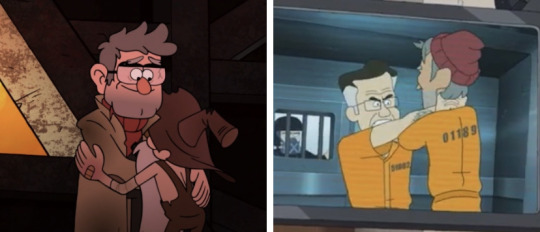
Ford and Fiddleford forgive and reconcile with each other, reconnecting after so many years apart. While Rand and J.R. never apologized to the other after the latter helped kick him out of the company and continue to be at each other’s throats.
#gravity falls#fiddauthor#stanford pines#fiddleford mcgucket#inside job#rand ridley#j.r. scheimpough#ford pines#fiddleford hadron mcgucket#tate mcgucket#reagan ridley#emma may dixon#tamiko ridley#ford²#journal 3#book of bill#meta#amba post
56 notes
·
View notes
Text
One interesting thing about The Hulk's role in the Hickman Ultimate Universe is that he's close to an inversion of his character in the original Ultimate Universe.
In the original Ultimate Universe, the gag surrounding Hulk- and much of what went into The Ultimates should be understood through the lens of a gag- was that his uncontrollable rage and homicidal toxic masculinity made him a millstone around the necks of the rest of the roster, their first major deployment being to get him under control after he loses his shit and kills 800 people in New York while trying to kill and eat Freddie Prinze Jr- an embarrassment that gets hushed up after the fact. In the grand finale of the first volume they barely, barely manage to get him aimed at the invading aliens by telling him the aliens called him gay, and then he still nearly eats Hawkeye before the tranqs kick in. He's less a part of the team than a barely directable bomb, emblematic of the fact that the Ultimates, collectively, do not have their shit together-it's a rotten idea to the core.
In the New Ultimate Universe, he's the one member of the classic Avengers lineup who's thrown in with The Maker, again standing in opposition to the rest of the team, but for the complete opposite reason. He's very visibly a road-not-taken of the Ultimate Hulk- same color scheme- but he worked his shit out, he found a self-help book, he became less insecure, less self-absorbed, altogether more functional. And it turns out that a "functional" version of that hulk comes out the other side as an Adrian-Veidt style of holier-than-thou Compassionate-enough-to-Kill-thousands-for-the-greater-good kind of figure, who callously tests the mutagenic effects of gamma exposure on isolated indigenous populations on the side. Fucker built nukes for the army- were we expecting a saint?
Anyway, this sort of leads into a thought I've been having about the comic in general, which is that with superhero comics it can be genuinely really hard to judge the dividing line between something that's cleverly meta and something that doesn't have the strength to stand on its own as a narrative without being composed of one million billion deep cut references. All the best cape comics are about cape comics. The actual stated project of The New Ultimate Universe is to create something so inextricably embedded in batshit comics continuity that no MCU adaptation is at all plausible, so, uh, mission accomplished? I tried to explain this specific Hulk-inversion beat to a non-comics-reading friend the other day and by the time I'd gotten through all the requisite context I was giving real Charlie Kelly without even the dignity of a good conspiracy board as a visual aid.
143 notes
·
View notes
Text
Possible Career Paths for the Sun Signs🌞
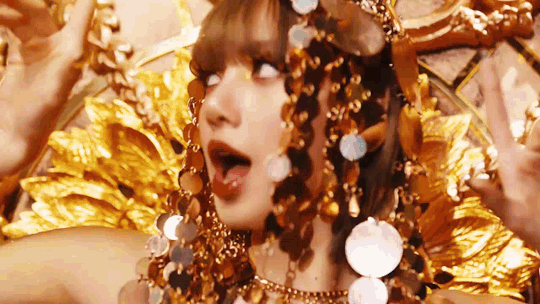
As I explained in my second Astro Observations post, the sign and house your sun is in can tell you where you naturally shine best. Working in a career where you stand out naturally can benefit you in many ways because when work does not feel like work, you have more room to thrive.
Sun in Aries/1H - Management, Military, Self-Employed Entrepreneur, Acting*, Modeling.
Sun in Taurus/2H - Banking, Finance, Singing*, Chef, Real Estate.
Sun in Gemini/3H - Writer, Radio/Podcast, Middle Education Teacher (ages 7-14), Athlete*, Entertainment Critic
Sun in Cancer/4H* - Family trade (Nepotism), Early Education Teacher (ages newborn to 7), Interior Decoration, Family Therapist, Historian
Sun in Leo/5H - Entertainer, Relationship Therapist/Dating Coach, Film Director/Producer, Youth Advocate, Late Education Teacher (ages 14-18)
Sun in Virgo/6H - Healthcare, Social Work, Human Resources, Comedian, Politician
Sun in Libra/7H - Lawyer, Mediator, At-Home work, Visual Artist*, Business Owner
Sun in Scorpio/8H* - Insurance Agent, Funeral Services, Sex Therapist, Addiction Counselor, Acting*
Sun in Sagittarius/9H - Theology, Post-Grade School Education (ages 18 and over), Travel Agent, Life Coach, Blogger
Sun in Capricorn/10H* - Business Leadership (ex: C-Suite), Family Trade (self-starting), Board Member, Politics, Entertainment Executive
Sun in Aquarius/11H* - Socialite/Influencer, Entertainer, Entrepreneur (with others), Humanitarian, Project Manager
Sun in Pisces/12H* - Psychologist, Executor, Jail/Prison Employee, Artist*, Occult Worker
Notes:
Actors, Singers, and Artists are usually found in all houses, but the work they go towards depends on the house they’re in. For example, Actors in Leo/5H tend to go for lighthearted roles like Will Smith, while Actors in Scorpio/8H tend to have darker-themed roles like Nicole Kidman.
Sun in Aquarius/11H can usually succeed in whatever career they venture into if they have passion for it because the 11H rules over hopes and dreams. It’s why most celebrities have 11H Sun.
Sun in Cancer/4H, Scorpio/8H, and Pisces/12H tend to have more mysterious or behind-the-scenes careers because the Sun prefers the attention to be on their work rather than on the person themselves.
Sun in Gemini/3H is good with athletics because the 3H is a social house along with 7H and 11H. Also, most professional athletes or athletic employees learn multiple languages to tend to their teams, which are made up of people from different cultures.
Sun in Capricorn/10H careers usually take time which is why the careers I listed are mostly leadership positions. These natives are ambitious so not being in charge is not a good direction for their sun energy.
Follow for more Astrology and Intuitive Content, readings are available! 💛
Tagged: @222-justfornow-333 @nummer626 @bcjkxs @starry-sky01 @mercurydombaby
#astrology#astro observations#astrology readings#sun placements#career#career astrology#1H#2H#3H#4H#5H#6H#7H#8H#9H#10H#11H#12H#Aries#Taurus#Gemini#Cancer#cancer placements#Cancer Sun#Leo#Virgo#Libra#Scorpio#Sagittarius#Capricorn
299 notes
·
View notes
Text
5 Days of Helping You Outline Your Next Novel

Day 5: Obsidian for Outlining
Find all 5 installments of the mini series: helping you outline your next novel
*I have added a layer of “static” over my screenshots so they are distinctive enough to stand apart from the surrounding text
did you miss this series? here you can find all posts here: [day 1] [day 2] [day 3] [day 4]

Do you use Obsidian?
What is Obsidian?
A note-taking and knowledge management tool that allows you to create and connect notes seamlessly.

Uses a local-first approach, meaning your data is stored on your computer, not the cloud (unless you choose to sync).
Features bidirectional linking, which helps create a non-linear, networked way of organizing ideas—great for brainstorming and outlining.
Why should you use Obsidian?
Flexible & Customizable – Unlike rigid writing apps, you can design your own workflow.
Distraction-Free Writing – Markdown keeps the focus on text without extra formatting distractions.
Ideal for Outlining & Organization – Connect story ideas, characters, and settings effortlessly.
Obsidian for Writing
Outlining
Creating a One Pager
Create a single markdown note for a high-level novel summary.
Use headings and bullet points for clarity.
Link to related notes (e.g., character pages, theme exploration).
Here’s an example of an outline I’m currently using. This is what my website will have on it (and what goals I hope to achieve w my website)

Using the Native Canvas Tool
Use Obsidian’s native Canvas tool to visually outline your novel. (Best on PC)
Create a board with columns for Acts, Chapters, or Story Beats.
Drag and drop cards as the story evolves.
Writing
Why Write Directly in Obsidian?
Minimalist interface reduces distractions.
Markdown-based formatting keeps the focus on words.
No auto-formatting issues (compared to Word or Google Docs).
Why is Obsidian Great for Writing?
Customizable workspace (plugins for word count, timers, and focus mode).
Easy to link notes (e.g., instantly reference past chapters or research).
Dark mode & themes for an optimal writing environment.
Organization in Obsidian
Outlining, Tags, Links
Each chapter, character, important item, and setting can have its own linked note.
Below, for example, you can see the purple text is a linked page directly in my outline.

Use bidirectional linking to create relationships between (story) elements. Clicking these links will automatically open the next page.
Tags can be used for important characters, items, places, or events that happen in your writing. Especially useful for tracking.
Folders for Efficient Storage
Organize notes into folders for Acts, Characters, Worldbuilding, and Drafts.
Use tags and backlinks for quick navigation.
Creating a separate folder for the actual writing and linking next (chapter) and previous (chapter) at the bottom for smooth navigation.
You can also create and reuse your own internal templates!
Spiderweb Map Feature (Graph View)
Visualize connections between characters, plot points, and themes. Below you’ll see the basic mapping of my website development project.

This view can help you spot disconnected (floating) ideas and create bridges to them.
Exporting
Why Export?
Ready to format in another program (Scrivener, Word, Docs, Vellum, etc).
Need a clean version (removing tags, notes, etc) for beta readers or editors.
Creating a backup copy of your work.
When should you export?
Personally, I like to export every 5 chapters or so and update my live version on Google Docs. This allows my family, friends, and beta readers to access my edited work.
After finishing a draft or major revision.
Before sending to an editor or formatting for publication.
Where should you export?
Personally I copy and paste my content from each chapter into a google doc for editing. You may also want to make note of the following export options:
Markdown to Word (.docx) – For editing or submitting.
Markdown to PDF – For quick sharing
Markdown to Scrivener – For those who format in Scrivener.
To Conclude
Obsidian is an invaluable tool for novelists who want a flexible, organized, and distraction-free writing process.
Try setting up your own Obsidian vault for your next novel! Comment below and let me know if this was helpful for you 🫶🏻

your reblogs help me help more ppl 💕
follow along for writing prompts, vocabulary lists, and helpful content like this! <333
✨ #blissfullyunawaresoriginals ✨
#writeblr#writers on tumblr#creative writing#writerscommunity#fiction#character development#writing prompt#dialogue prompt#female writers#writer blog#blissfullyunawaresoriginals#blissfullyunawares#writing life#fiction writing#writers#writer life#tumblr writers#writing inspiration#writing#writerslife#writer stuff#writing community#writer#obsidian for writing#obsidian#writers life#writing tool#writing tips#writer moots#tumblr moots
12 notes
·
View notes
Text
Your ultimate guide to glowing up physically and mentally in 2024.

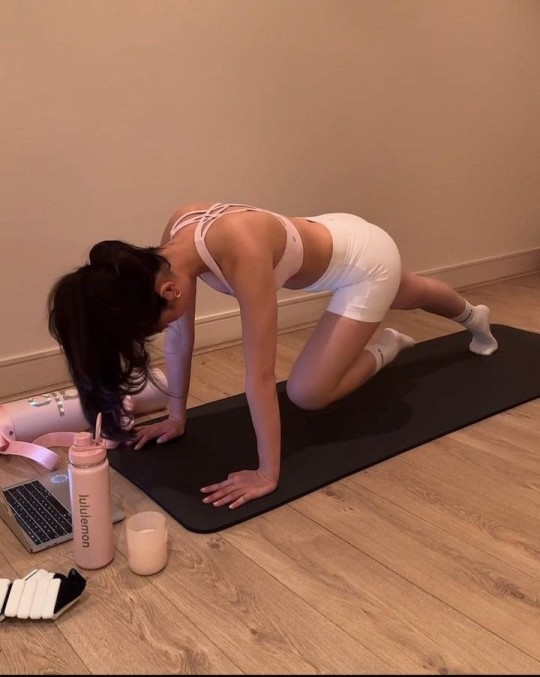

This is a guide to glowing up physically and mentally in 2024, including skincare tips, hair care, mental health, vision boards, journaling, and creating new habits to achieve your goals.
Physical Fitness:
Incorporate a mix of cardio, strength training, and flexibility exercises into your routine.
Focus on a balanced diet with plenty of fruits, vegetables, lean proteins, and whole grains.
Stay hydrated by drinking an adequate amount of water daily.
Skincare Routine:
Develop a consistent skincare routine with cleansing, moisturizing, and sun protection.
Consider adding products with ingredients like retinol and vitamin C for anti-aging benefits.
Hair Care:
Maintain regular haircuts and consider trying new hairstyles.
Use quality hair products suitable for your hair type to keep it healthy and shiny.
Fashion and Style:
Update your wardrobe with pieces that make you feel confident and comfortable.
Experiment with different styles to find what suits your personality and body type.
Mindfulness and Mental Well-being:
Practice mindfulness through activities like meditation or yoga.
Prioritize self-care and set aside time for activities that bring you joy and relaxation.
Create a vision board:
Identify your short-term and long-term goals
Collect magazines, newspapers, printed images, quotes, and any other materials you can use to represent your goals
Choose a board or poster as the base for your vision board. It can be a physical board or a digital one, depending on your preference.
Cut out images, words, and phrases that resonate with your goals. Arrange them on your board in a way that is visually appealing and meaningful to you.
As you place each item on the board, take a moment to visualize yourself achieving those goals. Feel the emotions associated with success.
Include positive affirmations related to your goals. Use words that inspire and motivate you.
Put your vision board in a place where you'll see it daily—this serves as a constant reminder of your aspirations.
Your vision board is a dynamic tool. Update it periodically as your goals evolve or as you achieve them.
Journaling:
Journaling can be a powerful tool for self-reflection, stress relief, and personal growth.
Establish a consistent time for journaling, whether it's in the morning, evening, or during specific events in your day.
Let your thoughts flow without judgment. Write about your feelings, experiences, dreams, or anything on your mind.
Include a section for things you're grateful for. This practice can shift focus towards positive aspects of your life.
Learning and Growth:
Read regularly to expand your knowledge and stay informed about various topics.
Set personal and professional goals to continually challenge and improve yourself.
Positive Relationships:
Nurture positive relationships and distance yourself from toxic influences.
Surround yourself with people who support and uplift you.
Cut off toxic people:
Detoxifying your social circle by cutting off toxic people is a crucial step for your mental well-being.
Remember, prioritizing your mental health and well-being is not selfish; it's essential for personal growth and a fulfilling life.
Organization and Time Management:
Create a schedule that allows for a balance between work, personal life, and leisure.
Declutter your physical and digital spaces for a clearer mind.
Hobbies and Passion Projects:
Cultivate hobbies that bring you joy and a sense of accomplishment.
Consider pursuing a passion project or learning a new skill.
Financial Fitness:
Develop a budget and savings plan to achieve financial goals.
Invest time in understanding personal finance for long-term stability.
#self love#inspiration#motivation#self care#self help#self improvement#becoming that girl#glow up#glow up era#manifesation#skincare#ultimate guide#glow in 2024#2024 goals#self growth#girlblogging#cut toxic people#positive mindset#pink blog#pink pilates princess#self awareness
66 notes
·
View notes
Text
平安京エイリアン | Heiankyo Alien
youtube
Heiankyo Alien: Pitfall Trap Game – 1979 Sep? (uncommercialized proof of concept) – Apple ][
Space Invaders was big, and Weekly Asahi magazine would run a story searching for the next big game, soliciting college computer clubs around the nation for new ideas. After visiting 2 at the University of Tokyo, Itaru Kawakami of the Theoretical Science Group (TGS) led an emergency meeting to come up with an idea before the article would be published. He put forth the idea of a game where the player is in their home attempting to trap cockroaches. Another member, Mitsutoshi Tabata, has implied that the idea would’ve played like a Snake type of game, and I’ve seen it cited that you would use glue traps, so perhaps the Snake element was the danger of getting stuck by your own traps as you lay more and more down. A fan creation of this game has since been made called Vermin Wars. TGS, however, were cautious about giving the player too much freedom of movement in an open space, so the playing field would be reimagined to resemble a Go board where you place pieces at the intersections of squares instead of within them, almost as if the lines are the streets and the spaces are buildings in a city grid. This changed their setting from a home interior to a city! With everyone talking about this new horror movie, Alien, they decided that could be the new monster that you trap. In brainstorming a city to take place in, they landed on the nation’s former capitol, once called Heiankyo, which had an impressively strict grid, making it an easy leap for them to then have you play as law enforcement of the time, attempting to dig pitfall traps for the invading aliens. Asashi would publish the idea, resulting in them being contacted by electronics company Denki Onkyo, who were interested. The group looked to Tabata to program it, as he owned the legendary Apple II, but the one thing he couldn’t do was optimize it. Apparently the game took 10 minutes to even boot, so Kawakami stepped up to optimize it and met Tabata at the train station to take the entire Apple II, which is humorous to imagine them lugging around. He would ultimately decide to switch to the Apple II’s low-resolution mode, effectively quartering the resolution and changing the available approach to visuals, resulting in humans, aliens, and holes being different colored blocks. This build of Heiankyo Alien: Pitfall Trap Game was taken to Denki Onkyo as a sort of proof of concept. According to an article instructing readers on how to make their own TK-80 version of the game in the February 1980 issue of I/O magazine, there were already PC-8001 and MZ-80K versions as of writing the article, with some version of the game being shown at a school festival the previous year, presumably the Apple II version.

Heiankyo Alien – 1979 Nov – cabinet
They were set up on the first floor of the Oda district office. Kawakami and Keiichiro Shimada would become the project managers, with the team fleshing out what should and shouldn’t be done. They changed the street layout to be less uniform. A timer was added to end the game in the event that the player closed themselves off from danger, and, inspired by the idea of using candy to distract the slit-mouthed woman of legend, they wanted to include a hard candy that can be used to temporarily stop all the aliens from moving, but midway through development scrapped the idea as they found it overcomplicated the controls. With a sole keyboard to type out what they wrote and burn it to ROMs, every time they wanted to test if what they came up with worked, multiplayer modes would be added, having you either take turns or co-op with both of you on screen together. One thing Denki Onkyo pressed them for was to give the player an animation for when they met their end, resulting in the last-minute addition of an angel sprite to float away. The game would be demoed at the Amusement Machine Show in October, where it was discovered that adding too many coins would cause the coin counter to spill into VRAM, removing one of the city walls, allowing one of the aliens to wander off, scrambling the game’s data, but when all was said, patched, and done, it would hit arcades (as Digger in the U.S.) to great success, being among the highest-grossing arcade games in Japan. Game Center Arashi was a book series about its protagonist conquering arcade games with its story about him attempting to score 10 million points in Heiankyo Alien in 20 minutes, spotlighting not only the game but its strategies and terminology, making them even more accessible. These were also detailed in I/O magazine, who, in their April 1980 issue, announced TK-80BS, MZ-80K/C, and PC-8001 versions for sale. Desktop versions of the game from the time are usually distinguishable by their use of green instead of blue, outside of the handheld version. I also notice the cover of Game Center Arashi has more square-shaped, pink aliens and green buildings while the city walls remain the blue that I’m used to seeing the arcade version be. The handheld version uses condensed, repeating stages and greatly simplified visuals to keep the core gameplay intact while maintaining portability and affordability. It would inspire many future games like its side-view counterpart, Space Panic.

Heiankyo Alien – 1990 Jan 14th – Gameboy
“Denki Onkyo was bought by Murata Manufacturing, and the rights were left hanging, but when the Game Boy version was released, they were transferred to a company called Hyperware, which was run by Takeshige Arimasa, who was a colleague of my brother-in-law at TSG.” -Norio Nakagata (alongside Takane Ohkubo are the Game Boy remake’s uncredited music artists)
As the 1980s rolled around, Denki Onkyo would not survive with the rights to Heiankyo Alien going up in the air. Hyperware was able to grab the rights and get to work on a remake. It features raising and lowering lanterns blocking the roads to keep the environment ever-shifting on the player and the monsters! A new boat mechanic allows you to traverse a river faster than taking the streets. Cinematics, including an ending, were added. While there would be a classic mode, the remake was rocking a faster pace to keep up with a new breed of alien sporting more erratic movement, and that’s not the only rocking being brought. The remake’s Multi Matrix Sound System (MMSS) is that when it’s multiplayer mode is linked to another Game Boy, it’ll combine both Game Boy’s sound systems into one, allowing for audio, twice as complex! The co-op of the original would return in classic mode, and the remake mode allows for competitive multiplayer where you each get your own screen and can affect each other’s game, sending aliens you’ve buried into their game as if you’re on opposite sides of the Earth, and those monsters evolve when they come up on the other side! The rebounded aliens can be taken out for good, and I have to mention how good the game’s overall branding is! The clean red, while only displaying the outlines of the monsters, is so classy yet harsh and vintage. Unfortunately for all involved, the remake did not seem well received in its time. Seemingly being dismissed as an overpriced repackaging of an antiquated 70’s game, even retrospective reviews years later were looking back on it negatively.

Nichibutsu Arcade Classics 2: Heiankyo Alien – 1995 Dec 15th – SFC
A new game for the SFC would attempt to try again with more screen real estate and modern graphics in the original game’s gameplay with multiple stages of dynamically dropping factors to deal with, from power-ups to power-downs to juke. This version would also not be a turning point for the series popularity. This also includes the ability to play “original” Heiankyo Alien, which plays like the arcade game but visually has an indigo background with green walls and buildings, which is not a color scheme of the official version of the ‘79 arcade game that I’m familiar with.

Heiankyo DX – 2003 Nov 17th – mova505i
After 2001 mobile versions, sporting both original and new graphics, a 2003 game titled Heiankyo DX would have you face 15 stages of alien tapping across night and day stages with further upgraded graphics. I’ve always wondered about the attitude toward mobile games from their regular players at this time. Perhaps the 2001 did alright to lead to Heiankyo DX, but the series overall 14-year absence following this gives me the impression it didn’t look like something with a lot of potential to commercially capitalize on, and I’d assume that simpler 1970s game design would have the best chance on phones at the time.

The 2017 Heiankyo Revival
Every time a new Heiankyo Alien came out, it would mention how popular the original game was, as, much like Space Invaders that inspired it, its original entry was something it never recaptured, but, just like Space Invaders, that’s not to say that not just the legacy but the idea of new games was not appreciated by players like the fan game that added guns, Heiankyo Crisis. By the 2017 revival, I note a general change in tone of people voicing their opinions of Heiankyo Alien from suspicious of its value as a commercial product to liking a new little game being offered, and I think the two factors that play into that are the lower relative price after inflation and in comparison to competition alongside Nintendo leading a shift in online and print discussions of home games away from almost only being the pushing forward of the bleeding edge of hardcore to also enjoying smaller, simpler games. By the early 2010s, Minecraft seemed to cement this rapidly growing market and general tone change in video game discussions, leading to opinions of not just new Heiankyo Alien games but older ones by first-time players seeming more open-minded to simpler than Triple-A games, though I do note Tetris on the Game Boy as an anomaly in this thinking. It again helped that people of the 21st century didn’t have to pay triple A price for Heiankyo games. Even outside of retro game prices in a pre-WataGames world, I remember people commenting in the 2010s how initial video game releases are cheaper than they ever have been due to the variance in prices on top of the great price reset PlayStation popularized. As of the publishing of this article, Triple A games are still less expensive than they were during the SNES generation. At least, that’s my suspicion for why the change in tone between the 90’s and 2010’s seemed to happen for Heiankyo Alien, but let’s get into what they actually offered!
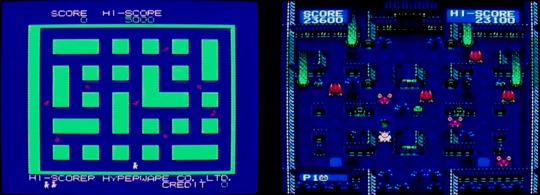
NEO Heiankyo Alien – 2017 Sep 7th – FC
NEO Heiankyo Alien is a Family Computer entry taking place in 299X where you can trap multiple types of aliens in a vibrant nightscape or play a version of the original that has a similar color scheme of the “original” mode in the 1995 game but neon blue and green, perhaps reusing the neon blue and green of Neo Kyoto in the new game mode. You could also just listen to the soundtrack featuring a nice list of composers in "Heiankyo Music" mode. Over the years, the soundtrack of the 1990 remake, since credited to Nakagata and Ohkubo, seemed to become the series identity, and Nakagata, who's credited as NEO Heiankyo’s producer, made a new song in that style for this game’s soundtrack too, though the show stealer for me was Bun’s song right at the top of the song list! There was a remixed version of the game’s soundtrack released, but it disappoints me that, unlike the Game Boy game, they never seemed to release the in-game version of the soundtrack.

Heiankyo Alien – 2017 Oct 13th – Windows 7-10
While Nakagata was working on NEO Heiankyo Alien, he was approached by Mikito Ichikawa, who heard Bug Fire was inspired by Heiankyo Alien and wanted to do his own remake of it for a series of remaking retro games that he was doing, resulting in another new Heiankyo game releasing! Now, technically there was a version of the original Heiankyo Alien officially released as shareware for Windows in 1999, but the 2017 game referred to as “Heiankyo Alien 3671” goes for a very colorful and enemy-filled rendition of the game as well as the ability to play a version of the arcade game that seems to be the more arcade-accurate (taller) aspect ratio with mock-ups of the cocktail table instructions used as borders, though it uses the same color scheme of blue roads and green buildings that NEO Heiankyo used, and I'm not sure if there was a version of the '79 arcade game in this color scheme. 3671, of course, also has quite the spotlight on music, even announcing an “Idol Version” in collaboration with a group called GUILDOLL. This never seemed to come to fruition, with people asking why the “idol mode” is grayed out in the menu years after the game seemed to stop being updated in 2021, despite advertising for it never being removed from the Steam store page. Even with that, the game is still generally praised by the minority that are aware of the Heiankyo Alien series.
10 notes
·
View notes
Text
Things That I Use To Help Manage My ADHD and Executive Dysfunction
1. To Do Lists
I know, I know.
Making a list is boring. I lose the paper. I forget to make the to do list.
Believe me, I know.
I've been there, but trust me it does help once you get into the habit.
Here's some tips on how to get started
Try making your list in a digital app or a document file so you don't lose it
Sticky notes in a place you're sure to see them
An erasable board like a marker board or a chalkboard that you keep up in a specific place and never move. Like on the wall or the fridge.
Put "make 'to do' list" on the to do list so you don't forget to do it
Set aside a certain time to fill out or check off the list each day. Consistency is key.
Use calendars, alarms, and timers liberally to keep track of appointments and to manage your time so you don't hyper-focus on something to the determinant of more important things
But be flexible for things that don't have deadlines or appointments. Don't beat yourself up if something doesn't get done, just add it back onto the list for next time
2. Randomizers
Part of the problem with executive dysfunction is being overwhelmed by choice. So I keep a few randomizer websites booked marked that I use regularly
Wheel pickers
List randomizers
Random number generators
Like I keep my list of projects on a wheel picker app. And my chores that I don't have deadlines for on another. When making my to do list I'll spin the wheel to pick the project or chore that I'm going to work on that day.
I do the same when picking out albums to listen to or movies to watch so I don't go doom scrolling while wasting time deciding.
3. Meal Planning
Similar to the above, I take one day out of the week to draw up my meal plan for the next week.
Use this time to take stock of your pantry and fridge. What needs to get used up?
Anything special you want to fix over the week or weekend? Save the recipes to a document or leave a bookmark in your cookbook
Overwhelmed with choices or just don't know what to do with certain ingredients? Try a randomizer or an app like supercook to come up with ideas.
After you've taken inventory of your kitchen and figured out any special recipes you want to make, go ahead and fill out your grocery list
Set aside time on your to do list for shopping, meal prep, and cooking through out the week.
Pre-plan what days/times you are going to eat out or get takeout and work that into the meal plan/budget
Budget not only your money but also your time. How long will this recipe take to prep/cook? How much effort will it require of me? Is there any shortcuts I can take to make things easier, like buying my veggies already diced?
Try using an app to keep track of your meal plan, grocery list, and recipes so that they're all in one place
4. Mental Health Apps
I like Booster Buddy, but it's no longer supported for newer devices. I have also used Finch. But at the end of the day it doesn't matter which app you choose.
The point of having a program dedicated for mental health is to have a handy way to check in on yourself and see how you are feeling. Many apps will offer visual cues to allow you to break down your motivation and energy levels.
This will help give you a guideline for the day so you don't stretch yourself too thin.
A good app will also offer little suggestions and tips to help improve your mood or provide genteel reminders for small things that help with self care.
But most importantly it will help you spot patterns over time so you can better notice ongoing problems or see gradual changes as you get better.
5. Finding and Avoiding What Triggers My Dissociation
This is the hardest one.
I suffer from Maladaptive Daydreaming on top everything else which only makes my ADD and Executive Dysfunction even worse.
For others it maybe obsessive compulsion or a tendency to hyper-focus.
Things that I found that can be triggers are boredom, anxiety, isolation, health/dietary complications, and even the weather.
So here's some things I noticed that help
Set aside a certain time during the day to read/watch the news and then ignore it for the rest of the day. Yes be informed, but don't obsess.
Get your news from actual reputable news sources and not social media! Avoid algorithms feeding you negativity.
If you want to be more politically active schedule time for it, get involved with actual charities or political organizations, and then go about your regular business afterwards
Limit social media time. For me it's mornings before work for about 30mins, and then maybe an hour after work.
Curate your online experience. Block what you need to. Unfollow who you see fit. Social media should be fun not stressful.
Talk to other people! Make plans to hang out on weekends or call/text someone during the weekday. Try to make contact with another human being in some form everyday for at least a few mins, even if it's just online in a discord chat.
Have a book or notepad handy for when you get bored at work. Read, write, or draw during your downtime so you don't start staring off into space.
Keep a short list of fun things to do handy if you feel bored at home.
Set aside time to daydream/worry/plan/meditate/decompress. You need to mentally unwind at some point. The goal is to have that time per-planned so that it doesn't distract from other needed tasks. Getting into a routine with that time will also help.
Eating enough iron/vitamin C/protein ect. Food is energy and you need energy to focus. Meal planning will help with this.
TAKE YOUR MEDS!!!
Sometimes the weather will make you groggy, irritated, or anxious. There's not much you can do about this other than to accept it and just try your best.
You can however plan for bad weather ahead of time. Go to the National Weather site to find out about upcoming weather in your area and to figure what you need to be prepared for it. Try getting into the habit of doing this regularly.
#adhd#mental health#I am not a doctor#these are just things that help me#they might be helpful you#but don't treat my advice as medical orders
15 notes
·
View notes
Text
Hell is terms like ASIC, FPGA, and PPU
I haven't been doing any public updates on this for a bit, but I am still working on this bizarre rabbit hole quest of designing my own (probably) 16-bit game console. The controller is maybe done now, on a design level. Like I have parts for everything sourced and a layout for the internal PCB. I don't have a fully tested working prototype yet because I am in the middle of a huge financial crisis and don't have the cash laying around to send out to have boards printed and start rapidly iterating design on the 3D printed bits (housing the scroll wheel is going to be a little tricky). I should really spend my creative energy focusing on software development for a nice little demo ROM (or like, short term projects to earn money I desperately need) but my brain's kinda stuck in circuitry gear so I'm thinking more about what's going into the actual console itself. This may get techie.
So... in the broadest sense, and I think I've mentioned this before, I want to make this a 16-bit system (which is a term with a pretty murky definition), maybe 32-bit? And since I'm going to all this trouble I want to give my project here a little something extra the consoles from that era didn't have. And at the same time, I'd like to be able to act as a bridge for the sort of weirdos who are currently actively making new games for those systems to start working on this, on a level of "if you would do this on this console with this code, here's how you would do it on mine." This makes for a hell of a lot of research on my end, but trust me, it gets worse!
So let's talk about the main strengths of the 2D game consoles everyone knows and loves. Oh and just now while looking for some visual aids maybe I stumbled across this site, which is actually great as a sort of mid-level overview of all this stuff. Short version though-
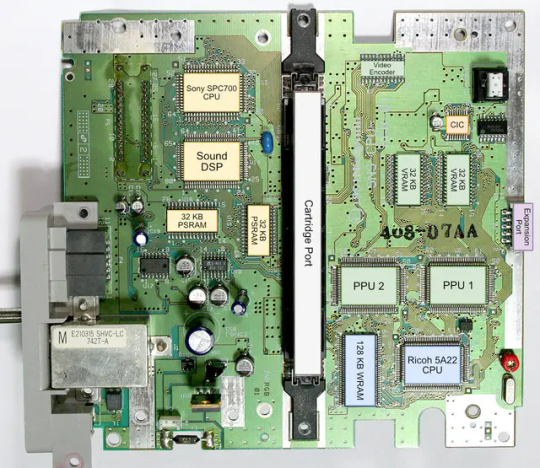
The SNES (or Super Famicom) does what it does by way of a combination of really going all in on direct memory access, and particularly having a dedicated setup for doing so between scanlines, coupled with a bunch of dedicated graphical modes specialized for different use cases, and you know, that you can switch between partway through drawing a screen. And of course the feature everyone knows and loves where you can have one polygon and do all sorts of fun things with it.
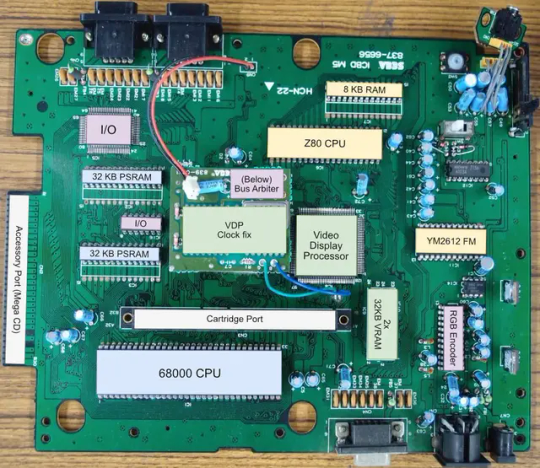
The Genesis (or Megadrive) has an actual proper 16-bit processor instead of this weird upgraded 6502 like the SNES had for a scrapped backwards compatibility plan. It also had this frankly wacky design where they just kinda took the guts out of a Sega Master System and had them off to the side as a segregated system whose only real job is managing the sound chip, one of those good good Yamaha synths with that real distinct sound... oh and they also actually did have a backwards compatibility deal that just kinda used the audio side to emulate an SMS, basically.
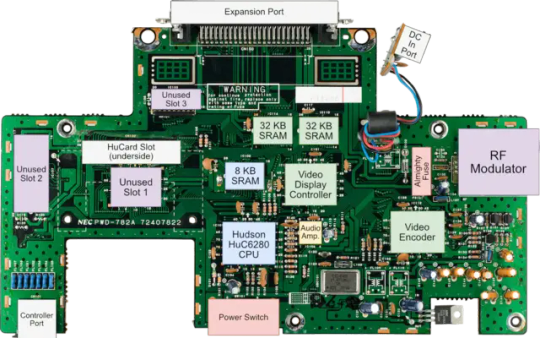
The TurboGrafix-16 (or PC Engine) really just kinda went all-in on making its own custom CPU from scratch which...we'll get to that, and otherwise uh... it had some interesting stuff going on sound wise? I feel like the main thing it had going was getting in on CDs early but I'm not messing with optical drives and they're no longer a really great storage option anyway.
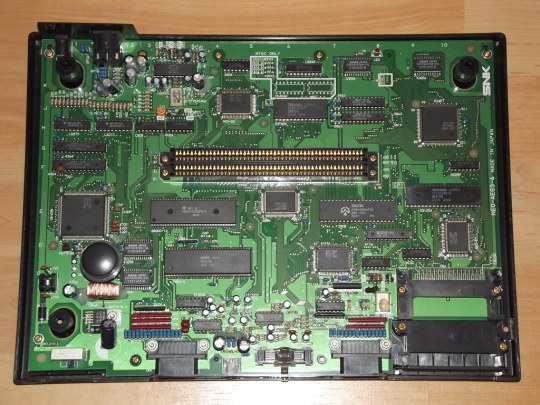
Then there's the Neo Geo... where what's going on under the good is just kind of A LOT. I don't have the same handy analysis ready to go on this one, but my understanding is it didn't really go in for a lot of nice streamlining tricks and just kinda powered through. Like it has no separation of background layers and sprites. It's just all sprites. Shove those raw numbers.
So what's the best of all worlds option here? I'd like to go with one of them nice speedy Motorolla processors. The 68000 the Genesis used is no longer manufactured though. The closest still-in-production equivalent would be the 68SEC000 family. Seems like they go for about $15 a pop, have a full 32-bit bus, low voltage, some support clock speeds like... three times what the Genesis did. It's overkill, but should remove any concerns I have about having a way higher resolution than the systems I'm jumping off from. I can also easily throw in some beefy RAM chips where I need.
I was also planning to just directly replicate the Genesis sound setup, weird as it is, but hit the slight hiccup that the Z80 was JUST discontinued, like a month or two ago. Pretty sure someone already has a clone of it, might use that.
Here's where everything comes to a screeching halt though. While the makers of all these systems were making contracts for custom processors to add a couple extra features in that I should be able to work around by just using newer descendant chips that have that built in, there really just is no off the shelf PPU that I'm aware of. EVERYONE back in the day had some custom ASIC (application-specific integrated circuit) chip made to assemble every frame of video before throwing it at the TV. Especially the SNES, with all its modes changing the logic there and the HDMA getting all up in those mode 7 effects. Which are again, something I definitely want to replicate here.
So one option here is... I design and order my own ASIC chips. I can probably just fit the entire system in one even? This however comes with two big problems. It's pricy. Real pricy. Don't think it's really practical if I'm not ordering in bulk and this is a project I assume has a really niche audience. Also, I mean, if I'm custom ordering a chip, I can't really rationalize having stuff I could cram in there for free sitting outside as separate costly chips, and hell, if it's all gonna be in one package I'm no longer making this an educational electronics kit/console, so I may as well just emulate the whole thing on like a raspberry pi for a tenth of the cost or something.
The other option is... I commit to even more work, and find a way to reverse engineer all the functionality I want out with some big array of custom ROMs and placeholder RAM and just kinda have my own multi-chip homebrew co-processors? Still PROBABLY cheaper than the ASIC solution and I guess not really making more research work for myself. It's just going to make for a bigger/more crowded motherboard or something.
Oh and I'm now looking at a 5V processor and making controllers compatible with a 10V system so I need to double check that all the components in those don't really care that much and maybe adjust things.
And then there's also FPGAs (field programmable gate arrays). Even more expensive than an ASIC, but the advantage is it's sort of a chip emulator and you can reflash it with something else. So if you're specifically in the MiSTer scene, I just host a file somewhere and you make the one you already have pretend to be this system. So... good news for those people but I still need to actually build something here.
So... yeah that's where all this stands right now. I admit I'm in way way over my head, but I should get somewhere eventually?
11 notes
·
View notes
Text
any excuse to make moodboards...
I just thought I'd share with you my personal visions for this story and the characters I'm going to be writing (honestly, I'll take any excuse to make a mood board), including their birthdays, interests, visual muses, aesthetics, etc.
If you agree with any of my visions, please let me know in the comments. I'd love to hear all your opinions and head-canons!
—୨୧—
Note: I gave all the characters the same last names as their voice actors (except for Alejandro, since they give us his last name in the show haha).
— ❥ —
Name: Courtney Lucille Barlow Birthday: October 17 (16 years old) (Libra) Interests/Hobbies: speech & debate, volleyball, reading, watching Gilmore Girls and The Vampire Diaries (guilty pleasures), student council, singing (but refuses to join the school choir), playing the piano, watching college vlogs and other youtube videos about college (her dream school is Yale) Visual Muse: (Cindy Kimberly)

— ꕥ —
Name: Bridgette Isobel Fairlie Birthday: June 25 (16 years old) (Cancer) Interests/Hobbies: surfing, swimming, marine biology, cooking vegetarian dishes, baking, crocheting (even though she's really bad at it), roller skating, riding on her bike, watching romcoms (she always cries at the happy endings), making candles, leading environmental club Visual Muse: (Sasha Pieterse)

— ❈ —
Name: Gwendolyn (Gwen) Ingrid Fahlenbock Birthday: February 8 (16 years old) (Aquarius) Interests/Hobbies: drawing in her sketchbook, painting, listening to Deftones, making playlists, binging reality TV shows (secretly loves the petty drama), painting her nails twice a week, helps make sets for school plays and stage manages, loves rainy days, smoking weed, messing with her cello, feeding stray cats Visual Muse: (Krysten Ritter)

— ♔ —
Name: Heather Saeko Wilson Birthday: January 11 (16 years old) (Capricorn) Interests/Hobbies: cheerleading, dancing ballet, keeping a following on social media, photography (she'd never admit it but she likes taking more than just selfies), watching sad romance movies and Gossip Girl, shopping, fashion, likes history (it's all just gossip), being around people (doesn't do too well alone, but would never admit it) Visual Muse: (Sandy Diana Bang)

— ✪ —
Name: Duncan Wilder Nelson Birthday: March 30 (16 years old) (Aries) Interests/Hobbies: skating, soccer, tagging graffiti everywhere (especially abandoned buildings), smoking weed, teaching his dog (Petey) tricks, loves late-night drives, listening to grunge rock, watching old movies, playing the drums, secretly likes going to vintage bookstores and record stores, loves a good Oreo McFlurry, secretly really good at math Visual Muse: (Zario Bolanos)

— ༄ —
Name: Geoff Bartol Petronijevic Birthday: December 3 (16 years old) (Sagittarius) Interests/Hobbies: surfing, swimming, wakeboarding, water polo, lacrosse (and is actually really good at it), partying, comedy movies, listening to house music and international music (especially eastern European), cooking for friends, is determined to throw a Project X-level party someday, actually really likes pottery and clay-making Visual Muse: (Brad Pitt)

— ✼ —
Name: Trent Theodore McCord Birthday: April 26 (16 years old) (Taurus) Interests/Hobbies: playing the guitar, listening to all genres of music, watching and reviewing great films (loves Letterbox'd), reading, writing songs and poems, surfing the internet, taking care of his little sisters when his mom isn't home, driving to scenic spots for song inspiration and some peace of mind, working a shift at the local daycare center Visual Muse: (Logan Lerman)

— ҉ —
Name: Alejandro Matías Burromuerto Birthday: August 13 (16 years old) (Leo) Interests/Hobbies: soccer, beach volleyball, singing, student council, theater and drama, posting on social media, flirting with random girls (but never seeing it through), partying, watching black & white films, always seeks to outshine his brother (often doesn't succeed), tutoring others (is really strong in all subjects) Visual Muse: (Xavier Serrano)

friendly reminder that this is all for my story now posted on wattpad and fanfiction.net, ENDGAME.
#total drama#total drama au#total drama fandom#total drama fanfiction#td courtney#td bridgette#td gwen#td heather#td duncan#td trent#td geoff#td alejandro#aleheather#duncney#td gwent#gidgette
17 notes
·
View notes
Note
Hiii!!!!!
I have a question and it's not necessarily Trouvaille related, so feel free to decide whether or not to answer!
I wanted to ask you about your writing process. I've been trying to get myself to write a longer piece of work for QUITE some time now, but I always chicken out. As a reader, I love your style. The ability to communicate effectively without sounding dry and lackluster, your character building, your storylines... they are what I hope to achieve in my own work. So some of my main questions are:
How do you work up the perseverance to stick with a project?
How do you stay consistent with a character or a storyline without getting carried away? Do you do something specific to get you in the head space of the story you're working on?
What are key things that you think helped you as a writer create more complex and intricate works?
How do you come up with a satisfying pace or arc for your stories?
And lastly, how much time do you spend on the storyline creation vs actual writing? Or do you tend to go with the flow more so than following an outline?
Again, no need to answer these if you don't feel like it.
Love your writing, and thanks for your great work. Trouvaille has gotten me through so many lonely nights while my partner worked overnights. I can't wait to see where it goes, and I'll keep my eye out for any new work from you!
Hello sweets!! Ah stoppp you're such a nice person, I'm happy to answer your questions Trouvaille related or not 💜 Also thank you for liking my writing and seeking out advice, that is such a wonderful compliment 🥺
Writing a story that has multiple chapters, long word counts, and/or both can be very daunting, but also rewarding! The key here is to dive into what you're most excited about. If an idea pops into your head (for example: perhaps a BTS Ot7 fic where they're princes, and MC is a princess) maybe you'll start with moodboards on Pinterest to get your "vibe" down visually. Maybe you're into music; you can make a playlist that captures the general themes of your idea to get you amped up to write. Gather books/movies/TV shows that share similar themes, and if needed, write down any research you'd have to make (for the Prince!AU, perhaps research royalty, societal classes in your target time period, apparel, etc.) This first step, gathering initial inspiration, is crucial in my opinion to "commit" to your idea and bring it closer to reality!
How do you work up the perseverance to stick with a project? This can be a personal thing, in my opinion. What I've written above is another way to keep persevering when tackling a longer written work; keep returning to your sources of inspiration and add to them if you come across new ones. I find if I'm lacking motivation to write, returning to my Pinterest boards to freshen them up, watching a movie that inspired a character, or updating a playlist gets me excited to write again or even give me new plot ideas! Other than that you can try two things that I've done A) Give yourself a deadline (not recommended if you struggle with those, but it does force you to work on time management and create a writing schedule) or B) Make a document where you briefly "dump" plot points or arcs that you have planned off the top of your head, then write a general drabble about the points you're most excited to tackle. You don't have to write everything in chronological order if you are struggling to get started!
How do you stay consistent with a character or a storyline without getting carried away? Do you do something specific to get you in the head space of the story you're working on? So what I've done to keep track of my character's general backstories and traits is make a separate document dedicated to that alone. I recommend making a profile for EVERY character, even the minor ones, just so you can refer to this profile whenever you forget details about them (this is particularly helpful for minor characters Ex. Ben, Laura, Alice in Trouvaille). Here you can list their physical appearance, personalities, media that inspired their character, backstories and families, etc. This rough document is crucial to me, and truthfully it is what I tackled before I even started Chapter One of Trouvaille. As for getting into the right headspace, I'd say it's all about writing about things you truly enjoy. I love spooky/paranormal things, so I knew that was going to be a theme in Trouvaille. I'm not a fan of sports, so I'd never write a sports!AU. Write what you like, and that's half the battle!
What are key things that you think helped you as a writer create more complex and intricate works? Inspiration, inspiration, inspiration! I'll say it until I'm blue. You gottttta go live life, enjoy good books and movies, and listen to an array of music genres. You'll never know what you'll end up liking! The best way to feed your imagination (which of course fuels your writing) is to sample many things life has to offer. Trouvaille is like a big quilt of many things I love (Ex. TV show Twin Peaks, movie Constantine, Alice is based off of a friend of mine, my brother lives in Wyoming like Namjoon once did, Jeongguk has experience with paranormal investigation like me!) Think of yourself as a weaver, connecting all of these things together. It can be hard to see how they fit, but it's a FUN challenge! Another important thing to remember is that your characters carry most of the weight of the story, so make them as realistic as you can! People aren't perfect, so give them flaws (Trouvaille MC is non-confrontational, for example), give them challenges and obstacles, and when you write dialogue, read it out loud to yourself to make sure that it flows naturally. Try not to use vocabulary you wouldn't use on a day-to-day basis. You do not need to compare a character's eyes to thirty different gemstones LOL!
How do you come up with a satisfying pace or arc for your stories? Unless you want a slow-burn, pace is entirely up to you! I love both slow-burn fics and ones that are more fast paced. Depending on your plot, some things happen more slowly than others. Falling in love usually doesn't happen over night. Resolving a huge fight can take time. If it's Ot7, stretching out how the MC gets with each of them can not only seem more organic but also can lengthen your work and give you time to develop other aspects to your plot aside from the romance (give it some meat!) Going back to what I said earlier, you can plan out basic bullet points to an arc that you're working on, then tackle each bullet point in your first draft to see what the pacing is like and if you're satisfied with it/it seems natural to you!
And lastly, how much time do you spend on the storyline creation vs actual writing? Or do you tend to go with the flow more so than following an outline? So! Honesty time! I usually dive straight into writing 💀 Since I've been writing Trouvaille for a little over two years, I usually come up with new arcs or wrap up existing ones by sitting down and going for it. I'm familiar with the characters by now and the BIG parts that need to happen, so the minor details and subplots come out while working up to the "main events". Very little time is spent on my separate docs for basic arcs these days, however, they were crucial in the early ones. I'm writing a new fic Sanctity, however, where I'm in the middle of creating storyline docs just to get my footing! So I'd say the further along you get creating a work, you feel more comfortable just going with the flow. Getting started is the hard part, so outlines are your friends until you are familiar with your characters and all of the plots you are working with ❤️
AH this was long I'm sorry but I HOPE hope hope it was somewhat helpful!! And I'm so glad that Trouvaille was able to keep you company, that means the world to me honey 🥺💕 I'm wishing you all of the luck in the world on your future works, you got this!! It's so rewarding 💜💜💜
10 notes
·
View notes